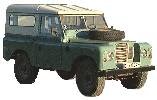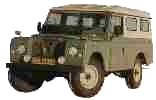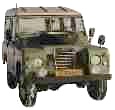|
Why
drive a Series III Land Rover?
|
||||||
 The
Land Rover Series III started production in 1971 by which time it's predecessors
the Series I and Series II / IIA had reached production of around 750,000
vehicles, since the introduction of the Series I prototype in 1947. Over
the years the design had acquired a few bulges, the engine had grown to
2,25 litres, and there had been some attempt at interior trim to resemble
standard saloon cars; but the basic idea of a box-steel chassis available
in two wheelbase sizes, with a diesel or petrol engine, 4 speed gearbox,
transfer-gearbox with high and low ratio and a neutral PTO gear, transmission
brake and heavy duty transmission chain and axles had not changed. In the
years which followed the Stage One, and later the Defender acquired larger
more powerful engines, so that the Land Rover of today is designed to compete
with the growing Japanese-supplied 4x4 market. The
Land Rover Series III started production in 1971 by which time it's predecessors
the Series I and Series II / IIA had reached production of around 750,000
vehicles, since the introduction of the Series I prototype in 1947. Over
the years the design had acquired a few bulges, the engine had grown to
2,25 litres, and there had been some attempt at interior trim to resemble
standard saloon cars; but the basic idea of a box-steel chassis available
in two wheelbase sizes, with a diesel or petrol engine, 4 speed gearbox,
transfer-gearbox with high and low ratio and a neutral PTO gear, transmission
brake and heavy duty transmission chain and axles had not changed. In the
years which followed the Stage One, and later the Defender acquired larger
more powerful engines, so that the Land Rover of today is designed to compete
with the growing Japanese-supplied 4x4 market.
The Land-Rover is one of the few vehicles which is built as a combination steel chassis and aluminium body. Some body parts are steel. This vehicle can be dismantled using simple tools and all parts can be replaced with either genuine spares, aftermarket spares, or more usually, spares from donor-vehicles. Most cars reach an age where expensive repairs are necessary to keep them on the road - the Land Rover goes one step further - having replaced or rebuilt the engine, gearbox or transmission after maybe 15 years daily use, the general mechanical condition of the vehicle remains so good that it is still worth investing in repairs to the other components which now begin to fail. Land Rover electrics, made mostly by Lucas, are famous for their erratic behaviour, though we often forget that the reason why such components on other vehicles are so "reliable" is that the other vehicles have been scrapped years before the windscreen-wiper motor wear out.
But economy is relative - Land Rover parts are widely available and easy to fit. The older the vehicle, the more simple - usually. It is evident from the land Rover design that the vehicle was built to last, and to be repaired by almost anybody, almost anywhere, using only the most basic tools, spares and materials. It is an easy vehicle to work on, there is plenty of space for big oily hands and tools. You don't "drive" a Land-Rover - you "run" it - owning a Land-Rover implies that you are just as interested in maintaining your vehicle as in getting from A to B - but the time invested in this work gives the enthusiast many hours of pleasure, and a vehicle which remains part of the family for many years. There are still many Series I, II, IIA and III vehicles on the road, and many of them run well and look as good as new. Land-Rover owners will always be the butt of humour from their friends who drive "proper" cars - you must be prepared for that. However, owning a Land-Rover admits you to an international brotherhood of like-minded four-wheelers, there are many clubs and internet-fora where you can get help and advice which makes running your car something very different from any having any other vehicle. Properly maintained, Land Rovers can deliver good fuel economy - my diesels give between 12 and 18 miles-per-gallon - but they are hungry when compared to lighter cars. Again, adequate maintenance and tuning means that Land Rovers can satisfy emission regulations in most countries. A regular tune-up is something you can do yourself every three months, it costs nothing, and does wonders for performance and emissions.
Most Land Rover owners devote lots of time to their vehicle, but retain a healthy attitude to using it - it is a working vehicle, and a few bumps and bruises to the bodywork are inevitable. What other car can you paint yourself - without it looking like a bodge-up? And contrary to popular opinion - it is possible to have a 25 year old vehicle which runs properly, is totally free of rust, doesn't smoke, and handles safely. Land Rovers are a "kit-car" you can convert them from hard-top (with or without windows) to soft-top (with or without hard-top cabin) or to a pick-up. There is a Station-wagon which seats up to 12, depending on your local registration laws, otherwise the Land-Rover is a two/three seater, with room in the back for more (again depending on local laws). My Land Rovers are as clean as any saloon-car, despite the fact that I use them to transport sand, cement, hay, wood, rubbish, animals and even children. What other car can you wash-out with a hose? There are many "rational" arguments for and against choosing a Land-Rover - at the end of the day, none of these arguments apply - it's simply a matter of personal taste. For some, the Land-Rover is just a noisy, rattling, smoking slow-boat without creature comforts to be avoided like the plague - whilst to others, the Land-Rover is a symbol of freedom and recreation, a way to enjoy the wider aspects of mobility, allowing you (in the words of one of my Internet Roverite collegues) "to get stuck in more inaccessible places". Land-Rover owners can be found in many shapes, sizes and colours, but they have much in common besides their cars - most are practical and humorous, and a helping hand or word of advice is usually freely given. Land-Rover owners wave to each other - total strangers pass each other in a foreign country, and wave! And when you park, be prepared to chat with a fellow Roverite who has seen your truck and pulled over to take a look - you will never be lonely with a Land-Rover! I hope this page can answer some of the questions which you may have about Land Rovers - otherwise talk to other Roverites - visit the Land-Rover Owners Net at http://www.Land-Rover.Team.Net/and subscribe to one of the mailing lists. Happy Rovering! Adrian Redmond
|
||||||
|
 The
Land-Rover Series III is a good daily driver in both hot and cold climates
- but it is not, and never will be a saloon-car. Forget airconditioning,
CD players and sound insulation - there is alas a price to pay for this
vehicles longevity. Likewise forget quick acceleration and life in the
outside lane of the highway - if you are looking for a nippy, comfortable
and economic saloon then the Land Rover is not for you!
The
Land-Rover Series III is a good daily driver in both hot and cold climates
- but it is not, and never will be a saloon-car. Forget airconditioning,
CD players and sound insulation - there is alas a price to pay for this
vehicles longevity. Likewise forget quick acceleration and life in the
outside lane of the highway - if you are looking for a nippy, comfortable
and economic saloon then the Land Rover is not for you!
 Contrary
to popular opinion, Land Rovers (and other four-wheel-drive cars) cannot
drive through anything - you have to keep at least three wheels in-traction,
on the ground. Off-roading improves your understanding of how a car works,
and you develop better control and technique, and you learn when to try,
and when to stop. Almost all Land-Rover owners have tried to drive their
truck through six feet of snow - this is not to be recommended, under these
conditions, the Land-Rover progresses as well as a tortoise sitting on
a stone with all four legs off the ground! We live and learn by our mistakes.
A winch can help get you out of a sticky corner, but the true art is learning
to avoid getting stuck to begin with. Experience helps, I have driven through
deep snow, sand, and even three feet of sea-water.
Contrary
to popular opinion, Land Rovers (and other four-wheel-drive cars) cannot
drive through anything - you have to keep at least three wheels in-traction,
on the ground. Off-roading improves your understanding of how a car works,
and you develop better control and technique, and you learn when to try,
and when to stop. Almost all Land-Rover owners have tried to drive their
truck through six feet of snow - this is not to be recommended, under these
conditions, the Land-Rover progresses as well as a tortoise sitting on
a stone with all four legs off the ground! We live and learn by our mistakes.
A winch can help get you out of a sticky corner, but the true art is learning
to avoid getting stuck to begin with. Experience helps, I have driven through
deep snow, sand, and even three feet of sea-water.